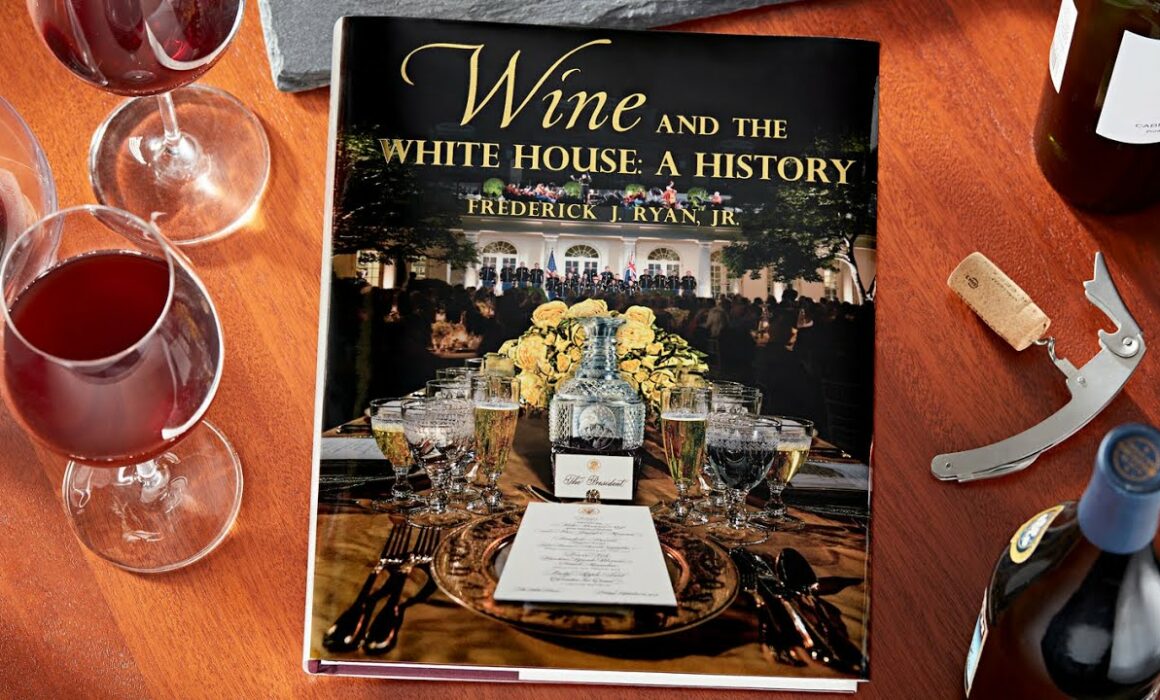Wine at The White House
By Virginie Boone
We could all use a little more wine right now. As it turns out, many American presidents liked wine, too.
Historian Frederick J. Ryan, Jr. has long been fascinated about the unique role of the American president and the history of the White House and has had a decades-long interest in wine. He put the two together in his veritable White House Historical Association tome, “Wine and The White House: A History.”
Ryan spent his preteen years in Italy (his dad was in the U.S. Air Force) where wine was a constant, before finishing high school in California, attending USC and exploring wineries throughout the state when he could.
In 1982, he worked in the White House of President Ronald Reagan, whom Ryan credits for “playing an important role in the rise of many California winemakers,” during his time as California Governor, and for bringing that knowledge and enthusiasm for wine with him to the White House, “where he took pride in showcasing America’s finest wines.”
Ryan believes that people who love wine and people fascinated with the White House have a lot in common.
“At their core, both groups are people who love learning about the past and connecting that history to the present,” he writes. “Wine aficionados… love history in their own way. A bottle of wine is in many ways a historical artifact. Millions of years of geology have gone into making just the right soil. Generations of careful viticulture have produced today’s grape varietals. Winemaking philosophies have developed over decades, often passed down as part of the rich histories of winemaking families.”
And so his book was born, detailing the ways in which all presidents have used the White House as a venue to showcase the finest wines made in America.
Among the stories shared about George Washington is the fact that he was “a Madeira Man,” drinking three or four glasses nightly of America’s most popular wine in 1776. Soon enough, Thomas Jefferson and Benjamin Franklin (a Champagne enthusiast!) helped introduce French wines to their peers.
Jefferson, our third president, who brought wines from Germany, France, Italy, Spain, Portugal and Hungary to the White House, believed mightily in America’s ability to make its own wines.
“We could in the United States, make as great a variety of wines as are made in Europe,” Jefferson wrote near the end of his presidency. “Not exactly of the same kinds, but doubtless as good.”
In 1807 he began growing grapes to make his own wines at Monticello in Virginia.
In 1864, President Abraham Lincoln, who grew up around Kentucky Bourbon but barely drank, was sent a gift of 1859 vintage California wines from the collector of the port of San Francisco. During the Civil War he and Mary Todd Lincoln hosted afternoon and evening receptions for the public at which wine was served.
President Theodore Roosevelt (1901-1909) fought back against false newspaper accounts (and the growing temperance movement) about his alcohol consumption in office by testifying, “I do not drink either whiskey or brandy; I do not drink beer; I sometimes drink light wine. At home, at dinner, I may partake of a glass or two glasses of white wine. At a public dinner, or a big dinner, if they have Champagne, I will take a glass or two glasses of Champagne.”
After a trial, the editor of the newspaper had to admit he was wrong.
By the end of President Franklin D. Roosevelt’s first year in office, Prohibition was finally repealed with the passing of the Twenty-First Amendment, and wine was served at White House State Dinners once again. Having First Lady Eleanor Roosevelt issue an edict to serve domestic wines at these dinners prompted official expressions of thanks from directors of the California Wine Institute.
Whether or not he enjoyed domestic wines, it is documented that when Britain’s wartime Prime Minister Winston Churchill visited Roosevelt, he enjoyed a tumbler of sherry at breakfast, Scotch and soda at lunch, Champagne with dinner, brandy after dinner and more Scotch and soda.
John F. and Jacqueline Kennedy entertained with many French wines, especially Veuve Clicquot Champagne, a favorite of the First Lady’s, but also opened many a California wine for guests. Almaden Pinot Noir was the first American wine to be served at a State Dinner in 1961. An Almaden Pinot Blanc was served in 1962.The Kennedys are also credited with establishing many of the traditions associated with the White House today, including the service of three wines at State Dinners: a light white for the first course, red with the entrée and Champagne (or sparkling) with dessert.
Lyndon B. Johnson was the first president to invite a young Robert Mondavi to a State Dinner for the Italian president; afterwards, Mondavi wines would be served at White House dinners for years to come.
A Korbel sparkling wine was served in honor of the Apollo 11 astronauts at an event hosted by President Richard M. Nixon in Los Angeles. Nixon also enlisted the help of another California sparkling wine, a 1969 Schramsberg Blanc de Blancs, in toasting US-China relations in 1972 with Premier Zhou Enlai.
Nixon, who often selected the wines for official events himself, preferred to have a German Riesling with the first course, a California Cabernet Sauvignon for the main course, and a French Champagne with dessert. “Tricky Dick,” as he came to be known, was also the inspiration behind the practice of “Pulling a Nixon,” a two-tier wine service wherein a fine selection would be poured into Nixon’s glass while other guests were served more ordinary wines.
The administration of President Ronald Reagan “saw wine service in the White House reach a level of interest unmatched since the time of Thomas Jefferson,” Ryan writes. “Reagan understood the importance of wine in entertaining and diplomacy, especially during the 1980s, when wine was rapidly growing in popularity in the United States.”
As the book details, after Canadian Prime Minister Pierre Trudeau first tasted a 1976 Jordan Cabernet Sauvignon at the White House, he ordered an entire case. It was at Reagan State Dinners that both California Zinfandel and Merlot were first served at the White House.
When Queen Elizabeth II visited George H.W. Bush in 1991, the dinner’s wines included a Swanson Reserve Chardonnay, Shafer Hillside Select Cabernet Sauvignon and J Vineyards sparkling wine from 1987.
Bush signed a law proclaiming the last week of February 1993 as “American Wine Appreciation Week,” recognizing, among other things, that “the history of winegrape growing in the world dates back over 7,000 years and it continues as a proud tradition nurtured by the small farmer in all regions of the United States… comprised of thousands of family-owned farms, many of which are passed on from generation to generation, sustaining responsible preservation of our agricultural resources.”
President Bill Clinton served a 1991 Peter Michael Chardonnay and 1985 Piper Sonoma Têtede Cuvée sparkling wine to South African leader Nelson Mandela as well as a 1991 Iron Horse Blanc de Blancs to Chinese President Jiang Zemin; President Barack Obama served a 2012 Pride Mountain Vintner Select Merlot to Chinese President Xi Jinping.
Simi, Sonoma-Cutrer, Dry Creek Vineyard, Hacienda, Chateau St. Jean, Balverne, Schug Winery, Marimar Torres, Gloria Ferrer, Kistler, Landmark, Paul Hobbs, Selby, Ridge and Hartford are among the other very worthy Sonoma County producers found on White House menus over the decades.
In the end, let us contemplate this, not from an American president, but from one of America’s most important founding fathers and lovers of wine, Benjamin Franklin: “Wine makes daily living easier, less hurried, with fewer tensions and more tolerance.”
Cheers to that.
Image by White House Historical Association


